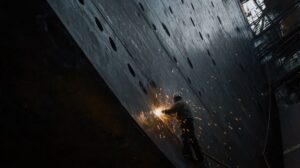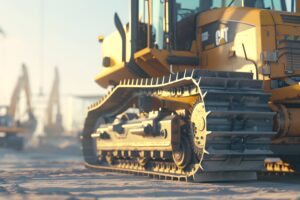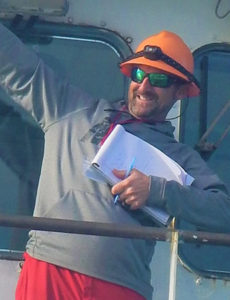- May 4, 2021
- Industry, Marine News
- So, What About Offshore Wind Farms?
We are headlong into the new world of wind power. Not so new if you consider that Hero of Alexandria (20 AD-70 AD) invented a windmill that pumped a bellows attached to a pipe organ. (And he invented the first vending machine – it dispensed holy water). The first windmill to provide electricity was built in 1887 by a Scottish inventor, James Blyth, to power his home.
Reading the various maritime newsletters and commentary about the future fuels that will be used in the industry, I’m reminded of the old joke framework where a subject is laid out like an announcer calling a horse race.
We are like tenant farmers chopping down the fence around our house for fuel when we should be using Nature’s inexhaustible sources of energy – sun, wind and tide. … I’d put my money on the sun and solar energy. What a source of power! I hope we don’t have to wait until oil and coal run out before we tackle that.”
Thomas A. Edison
The interest today is in offshore wind farms. This article will be a primer to help us better understand some parts of this growing industry. One thing I’ve learned, wind farms have a lot of parts, both fixed and moving.
The first offshore wind farm was built off the coast of Denmark in 1991. It was made up of eleven 450 KW wind generators and was shut down in 2017 after 26 years of operation.
The first offshore farm in the United States was built offshore of Block Island in 2016. It has five 6 MW turbines for a total output of 30 MW.
Here is an idea of the growth in offshore wind farms as of 2020: For wind farms of over 200 MW total capacity, there are 60 in operation – 40 of them are in the North Sea/UK region and 11 off the coasts of China.
Now under construction, of over 400 MW total capacity, there are 13 – seven around the UK and five off the coasts of China and Taiwan. Proposed are 16 – ten for the UK, three in Asia and two offshore United States.
It isn’t just about how many farms there are, but also how large the farms are and are becoming. For example, at the end of 2020, China’s reported total capacity, on and offshore, was 281,990 MW, the entire EU region was 201,507 MW, and the U.S. was 117,744 MW. Offshore capacity alone was 344 GW.
In nature, wind is a form of solar energy. Heating and cooling of the earth’s surface creates winds. Approximately 2% of solar energy becomes kinetic, i.e., wind energy. To go beyond that, something called Betz’s Law states that only 59% of wind can be converted to energy, then there is additional loss of efficiency due to the machinery creating rotation and generating electricity.
If you would like to work out your own numbers all you need for Maximum Power Co-efficient (Cp) are such things as air density (p) rotor swept area (S), rotor diameter (D) and wind speed (V) cubed. And look up Betz’s Law. As a sailor, I do understand resistance as the square of wind speed.
And it is not exactly “wind energy” that powers the streetlights. Wind strikes the blades which are on a shaft, the shaft turns a rotor inside a generator, which in turn produces the electricity that eventually get to those streetlights.
Nothing to it. Unless you want to do it efficiently. So one has to throw in a few more pieces like the shaft being the slow speed shaft which runs to a gear box then via a high speed shaft to the rotor in the generator.
But you start with wind. At sea there is nothing to block the wind. However, close to the water surface there will be drag and air turbulence from waves. The higher you go the clearer and stronger the wind, so the taller the tower the better the wind. Offshore tower heights are currently in the range of 200 to 300 feet. Since larger blades will catch more wind, the taller the tower, the longer you can make the blades; however, the bigger they get the heavier they will be, so you lose efficiency. The blades must be made out of special lightweight but very strong materials.
The wind farms we see are generally of the Horizontal Axis Wind Turbine type (HAWT). This means that the shaft that turns the rotor in the generator is horizontal and the blades are vertical. These vertical blades are mounted on a pivoting cap called a nacelle, so when the wind blows the blades will self-align with the wind, but downwind of the tower. With this design the tower itself partially blocks the wind before it gets to the blades and creates turbulence; therefore, loss of efficiency.
If we want the blades in the “clean” air in front of the tower there must be something like a vane that works with the nacelle and would catch the wind and align the blades at right angles to the wind (yaw control). Only, with these heavy blades and machinery, it would take a gale to swing the weighty machinery into the right alignment. Part of the job of the yaw system is to mechanically keep the rotors at the most efficient angle to the wind. There are some varied opinions on the most efficient wind speed, but it generally seems to be that power can be efficiently produced with winds between 8 to 55 mph (13 to 90 kph). To protect the machinery when the winds are too strong, the towers are fitted with a computerized braking mechanism for the blades.
While the above description was to describe why offshore units are like they are, it is also to point out their complexity.
An offshore 300-foot tower takes an enormous foundation. And it takes some amazing marine equipment to lay the foundation or secure points for future floaters, erect the towers, install the rotors and turbine, and deliver and attach the blades. New generation blades weigh over 20 tons and must be lifted and attached at a point over 250’ above the sea surface. Also realize that those blades spinning at 10 to 20 RPM are in effect a giant gyroscope acting on the tower. The blades themselves twist as they spin between being in a horizontal and vertical position. The entire system has near constant vibration and cyclic stresses.
The bottom line is there are many reasons why they are so expensive.
Let us also add that individual tower spacing is a big factor in creating an efficient offshore wind farm. To avoid inter-tower turbulence and reduced efficiency, the towers must have wide spacing. One source says spacing should be 6 to 10 rotor diameters apart. The higher kilowatt units offshore may require greater spacing, but the wider the spacing the higher the cost of the subsea connections and delivery infrastructure such as substations. The longer the cable runs the greater the loss of deliverable electricity.
One more fun fact: It has been reported that up to 80% of paid insurance claims for wind turbine damage, on and offshore, have been due to lightning strikes. Salt laden air is also not as healthy for this equipment as dry mountaintop air.
Despite the complexity involved, the per kilowatt cost of wind powered electricity continues to drop. Every year. Part of that is due to improvements in science and efficiencies of scale from individual parts suppliers and builders/erectors. Other factors, according to one study, will be a drop in operating costs, increased capacity, increased design life and even lower financing costs as risk factors drop.
On the commercial side, a utility scale wind generator is one that is at least 100 KW. Modern offshore units are beyond that and must be economical to offset the capital costs of installation. The first U.S offshore units off Block Island were each 6 MW. The proposed farm off the coast of Virginia will have a capacity that varies by the source of the information. There is mention of 188 towers but various figures on total output make the rating per tower vary from 6 to 14 MW.
For comparison, the Borssele III and IV farms off the Netherlands, put into operation in 2021, have seventy-seven 9.5 KW Vesta units.
There is a forecast that by 2026 the United States will have an offshore wind turbine capacity of 5.3 GW from the current level of 4,200 GW. Difficult to believe.
For those who want to learn more about wind farms and installation, try these websites:
This first is a bit dated, from 2019, but gives a lot of statistics: https://www.nrel.gov/docs/fy21osti/77411.pdf
This one is an amazing blog by an experienced wind farm project manager. It is not about offshore but his various entries cover the true “nuts and bolts” of wind farm installation: https://www.windfarmbop.com/
As a follower of doveryai, no proveryai, (trust but verify) for those who might wonder if Edison was really talking about green energy 100 years ago, this is what I found: https://quoteinvestigator.com/2015/08/09/solar/
Knowledge about offshore wind farms is of interest to most of us in the marine industry. But DLS Marine has been getting deeper involved.
Our drone inspection program has been accepted by ABS and by lenders and lessors. With our Norfolk office near the Coastal Virginia Offshore Wind (CVOW) project, we are working with our exclusive partners, DroneUp, for drone inspections of wind farm towers, starting with experimental inspections of the two test towers currently in operation.
More details on these inspections and the DLS/DroneUp partnership will be coming out in a few weeks.











